What color is Mars?
Today I will take up a topic that is already utterly hackneyed, but it still steadily emerges in almost any discussion of the RuNet, where the words "Mars" and "NASA" appear. Let's talk about the color of Mars. I know that many people already have this topic in their livers, like me, but that's why I took it. It is necessary once and for all to put all the arguments on the shelves and put all the dots.
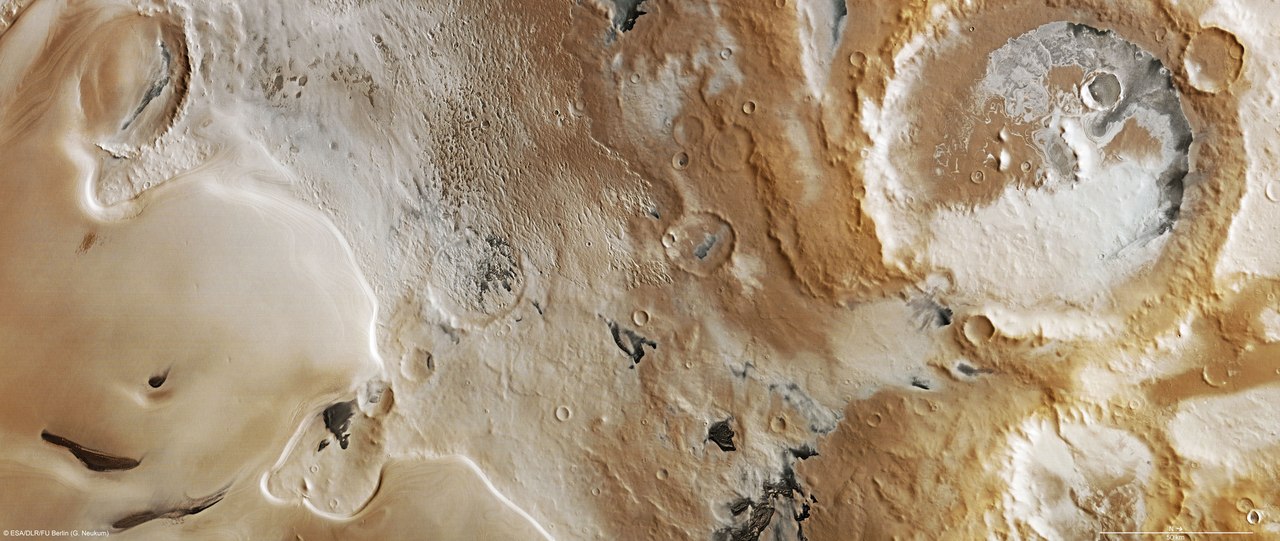
To begin with, we will analyze all the main arguments of the supporters of the theory of “NASA hidden the color of Mars”. They do not have much evidence, but if they are not explained, doubts can arise even from a person far from conspiracy.
The favorite method of conspiracy therapists is to pull the facts, to ignore the explanations and to present them under their interpretation. Therefore, it is only necessary to show how manipulative all these conspiracy theories are. Yes, I think that the initiators of all these disclosures of conspiracies are well aware of their absurdity, but the losers is a valuable RuNet resource that can be converted into traffic and hundreds of links to your website or youtube channel.
So let's get started.
This whole story and hysteria began when photos from the Spirit and Opportunity twin rovers began to arrive in large quantities. Someone thought it strange that on Mars burgundy soil and beige sky, and then they came across an official picture of the Spirit landing platform.

“What is this?” - then the American losers gasped, unable to read the descriptions under the photo - “Why is the NASA emblem burgundy and not blue?”.
')
And really, why? NASA will not be so stupid to burn: to hide the true color of Mars (we will bypass the question why it is generally necessary), and at the same time leave color clues that any conspiracy theorist could expose the plot.
But all you had to do was look at the description of the photo and find out that these frames were made using not the red filter, but the infrared one. Color photographs on the twin rovers were created by shooting a black and white camera through different color filters. There, each camera had seven filters with different wavelengths, slightly different on the right and left, among which was red and infrared.

Read more about getting color images from the rover cameras: it has been written for a long time .
A bit of theory: the color frame is obtained if you shoot through three filters: red, green and blue (RGB format: red, green, blue), and then combine three frames in Photoshop to get one color.

In some cases, NASA did not use a red filter, but an infrared filter. It was necessary in order to obtain extended information about the properties of the soil and the objects under study. After all, the camera rover - is primarily a scientific device, and only then a means for entertainment taxpayers. So the panorama, with the landing platform Spirit was removed using an infrared filter. But at the same time, the Opportunity platform was removed using red and in normal colors, as can be seen from the difference.
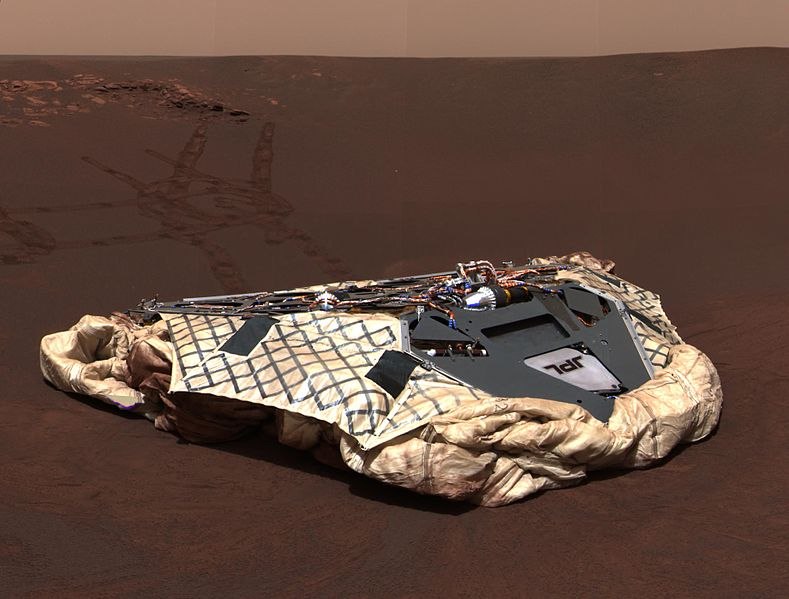
The emblem of NASA is not visible, but the blue electrical tape immediately catches the eye. But if you look at the difference in the soil in these two photos, then it is not so significant. It is “redder” through infrared, but you still cannot see it on the original green grass and blue sky.
The peculiarity of getting color shots through three filters caused another accusation of NASA that they post many black and white shots and very few color ones. First, “little color” is nonsense, because even before Curiosity, thousands of colored frames of Spirit and Opportunity were published, and dozens of huge 360-degree panoramas. Secondly, by laying out raw black and white frames made through color filters, NASA gives everyone the opportunity to make color images of Mars on their own. But conspiracy theorists master Photoshop only up to the Autocolor function, which they “restore the true color of Mars”, and the subtleties of working with color channels are unknown to them.
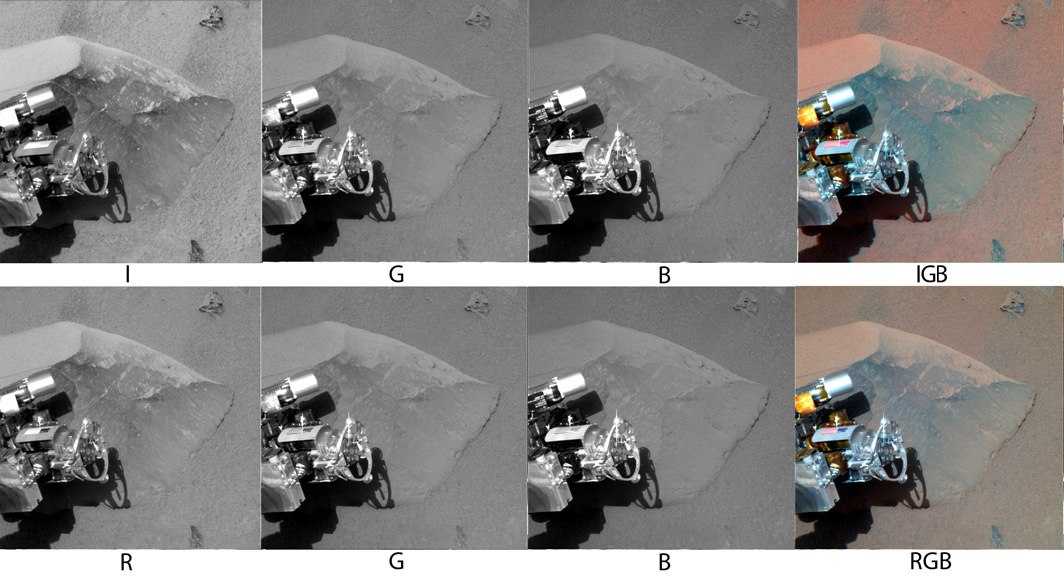
The next argument of the adherents of the Mars-Red exercise is a kind of BBC report about the work of NASA specialists. According to the program, the scientist is sitting at a working laptop, then journalists enter his office, and they ask something there.
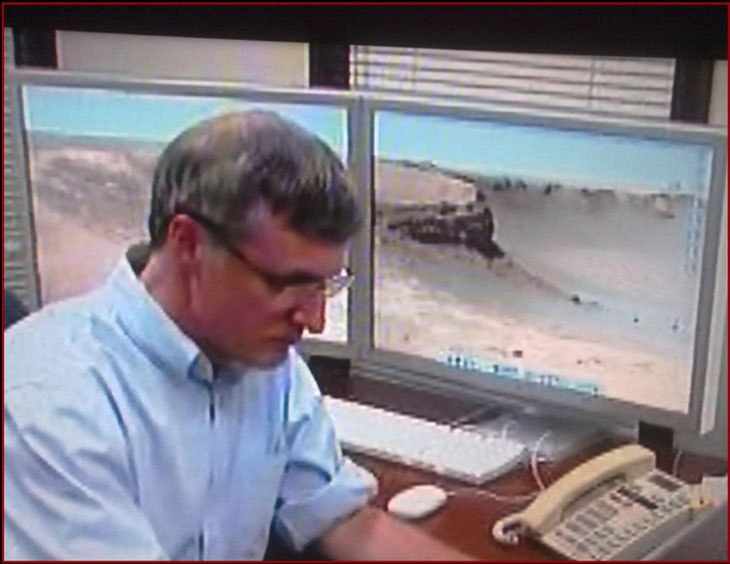
But the conspiracy scientist shouts “Aha!” And pokes at the monitors behind the scientist’s back, and there’s no red Mars and blue sky. At the same time, the organization of conspirators on a global scale looks more than strange, where journalists with cameras quietly roam around the offices, looking to where they like it. But those who dream of catching NASA in a lie do not think about it.
So what's on that monitor? It shows the Cape Verde site of Victoria Crater, which explored Opportunity.

NASA scientists use processing for terrestrial lighting conditions in order to facilitate the definition of rocks of rocks that occur to rovers. Since geologists' eyes are accustomed to terrestrial conditions, the change in the color range of Martian images is made in the same direction. And these photos are not at all secret.
Here is Cape Cape St. Mary is next door to Cape Verde

A source
And this is generally hearty Cape St. Vincent.
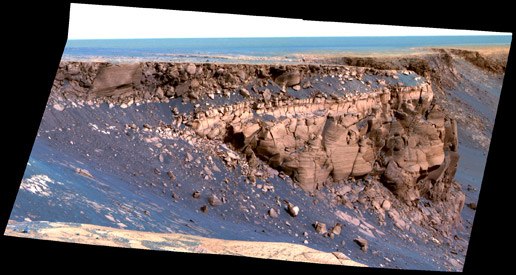
A source
Or the crater of Santa Maria, which Opportunity drove last year

A source
But this photo was taken using 13 color filters.

A source
Can you imagine what would happen if journalists caught a scientist editing this photo? "NASA hides that the rovers landed on a rainbow!"
Just in the published photographs, an explanation of the type is always indicated: It is presented in different colors. Or in the case of this rainbow photo: It was taken using all 13 color filters. But those who see traces of conspiracy everywhere cannot read.
In addition, conspiracologists, apparently, do not know about the existence of dust. Otherwise, they would not take NASA as another proof of the conspiracy.

This is a memorial flag, placed in memory of the victims of 9/11 on the Opportunity manipulator. And attention is attracted by the fact that it seems that it is tinted in red. Conspiracy therapists think that this is proof of the use of the red filter, although it is simply red-colored Martian dust. The frame was taken in 2011, and if you look at the photos taken in 2004 at the beginning of the research operation, for 31 sol (Martian day), then there is a clean flag in our familiar colors.
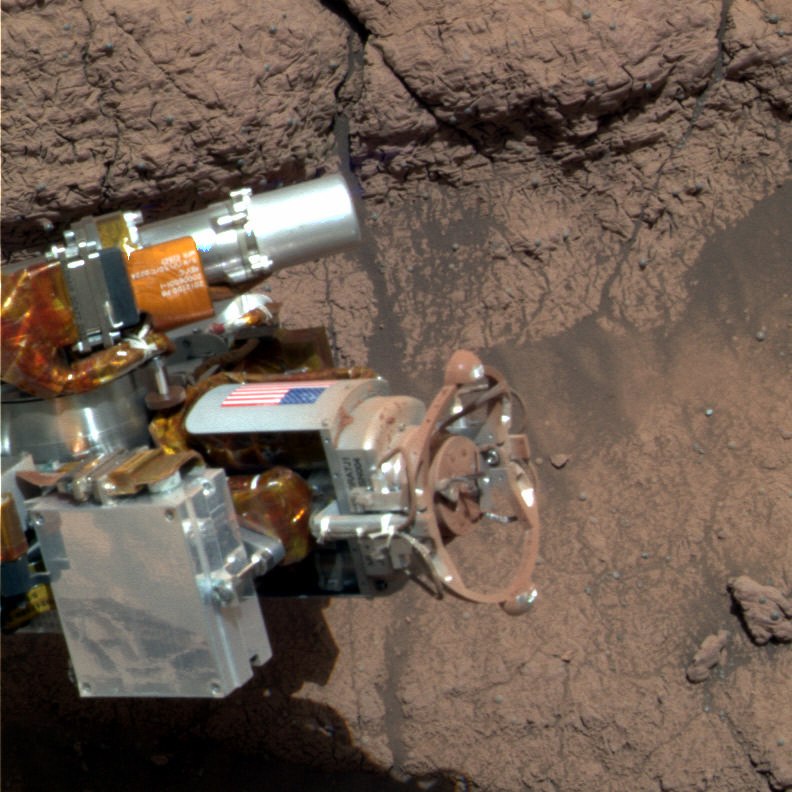
When the big self-portrait of Curiosity appeared, there too some tried to look for traces of the plot.
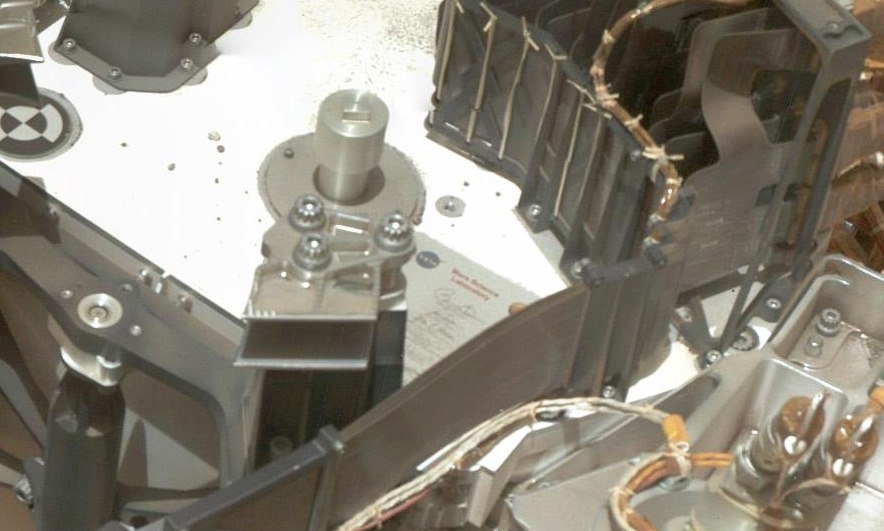
“Something NASA emblem is kind of gray, but it’s blue,” but they also forgot about the dust. The MSL was not landed using inflated cocoons, like previous rovers, but with the help of Sky Crane, so that it was sprayed on from the first seconds on Mars.

UPD. Applying the brush to the surface of Mars showed its natural color.
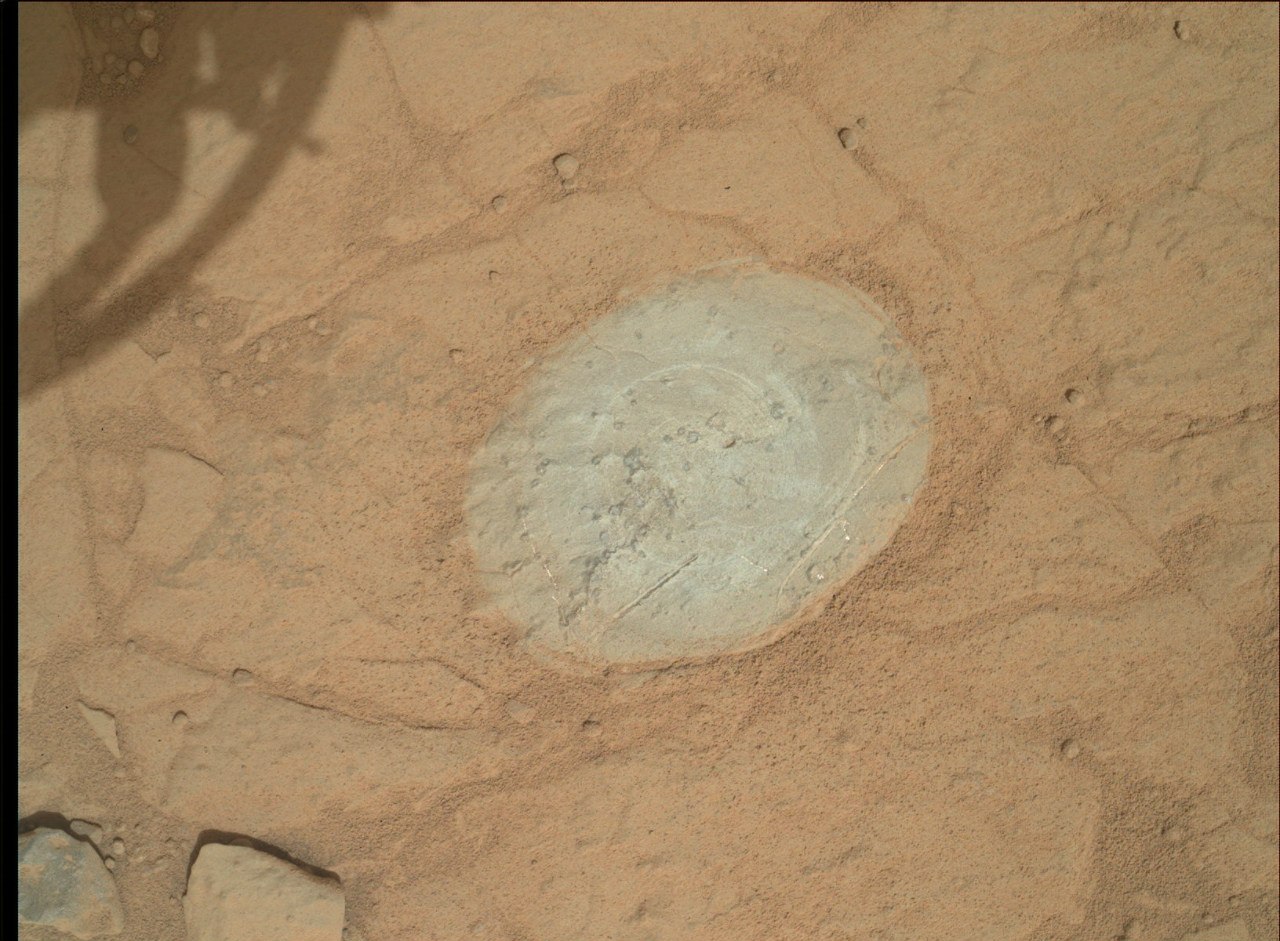
They also tell a certain story about how the first image of Mars was obtained from the landing gear Viking 1.
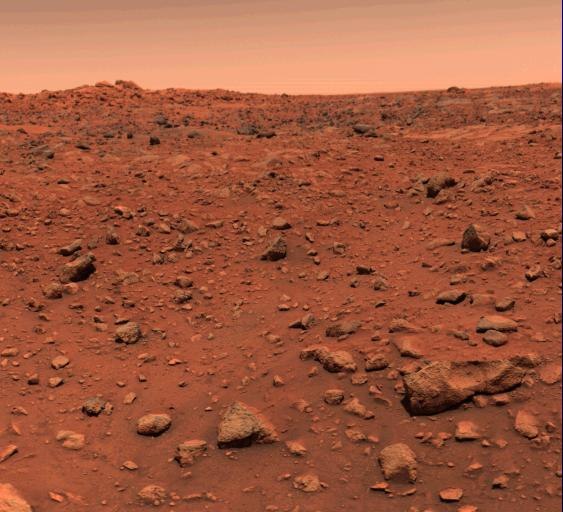
The book, the authors of which prove that there is life on Mars, and NASA hides it (Mars: The Living Planet, by B. Di Gregorio, G. Levin and P. Straat, Frog Ltd, Berkeley, 1997) tells the story of first shot. According to their testimonies, JPL gathered journalists, placed color television sets everywhere, and after receiving a snapshot from Mars, they immediately brought it to the screens. The picture allegedly had a blue sky and green spots on the stones. After that, as described in the book, NASA experts ran from the monitor to the monitor, twisting their color setting so that the photograph of Mars was in red. It is no longer possible to check the authenticity of this story, but there are two significant points: first, the color Viking frame was obtained in the same way as on the twin rovers - by combining three black and white images, so there was no signal from Mars that needed would immediately display on monitors; secondly, if an image was transmitted from the next room on the monitors, where the color reduction of the frame was made, wouldn’t it be easier to replace it with “red” and continue broadcasting than to attract attention by adjusting the monitors in front of everyone?
Thanks to the hysteria injected by the conspiracy theorists, the question began to worry: so what is the color of Mars and the Mars sky in reality? Let's see.
The main culprit of the red color of Mars is iron oxides, or simply rust. Martian crust was very rich in iron ore. For example, the plateau of Meridiani, where Opportunity rides is simply strewn with hematite - iron balls formed in shallow water bodies or groundwater.

Under the influence of water in an oxidizing atmosphere, iron turns to rust, which, as those who work with metal can easily know, easily becomes fine, fine dust. And once there was a lot of liquid water on the planet for a long time, so Mars had time to turn red. According to NASA observations, all the dust on Mars has magnetic properties, i.e. contains impurities of iron.
Martian storms carry dust even to places where there is not much iron in the soil. For example, in the Gale crater, at the landing site of Curiosity, the jet streams of the landing gear blew away dust and a gray surface emerged.

But in a matter of days, everything returned to the usual red picture.

But in general, the landscapes there are lighter than on the plateau of Miridiani.
In the same way, the rover itself was covered with dust, therefore, considering its color markers and the body, or trying to restore the “true color”, it should be borne in mind that it contains red Martian dust.
I don’t want to touch on the subtleties of color calibration white balance here. We tried it once, but I'm not happy with the results and have already got used to the “raw” (raw) colors of Curiosity.

Formats more
Let me just say that the Curiosity color cameras, unlike their predecessors, have a standard color Bayer filter on the Kodak KAI-2020 CCD matrix, so they shoot like ordinary SLR cameras. The difference in color reproduction depends on the white balance setting. But on Earth, adjustments to the color balance of the camera were made by people who knew what a particular color would look like at one or another color temperature. There are no people on Mars yet, so there is no one who could say “This is the right color” and slight variations of color are taking place. For supporters of the theory that NASA is shooting everything through a red filter to hide the green Mars, I’ll share the secret that in Curiosity's raw images there is just a slight bend in yellow-green.

So what Mars looks like from space is much easier. We have photos of "Viking"

Hubble

Mars odyssey

If someone does not trust NASA can look at the images of the European satellite Mars Express
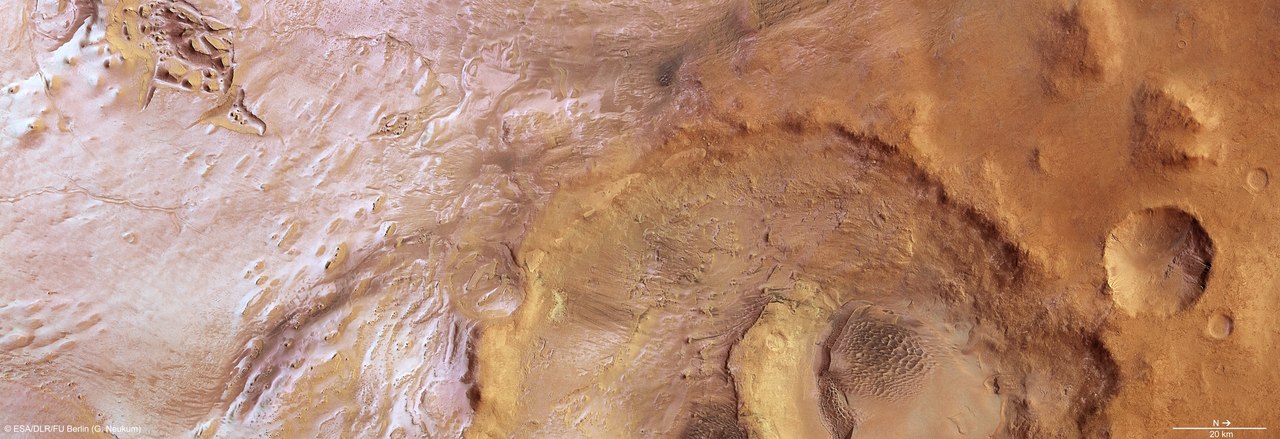
The photo at the beginning of the article is also his.
Or a beautiful true-color photograph of a European satellite Rosetta

(Round "horseshoe" just to the left and below the center - Gale's crater )
Or even the Soviet "Mars-5"
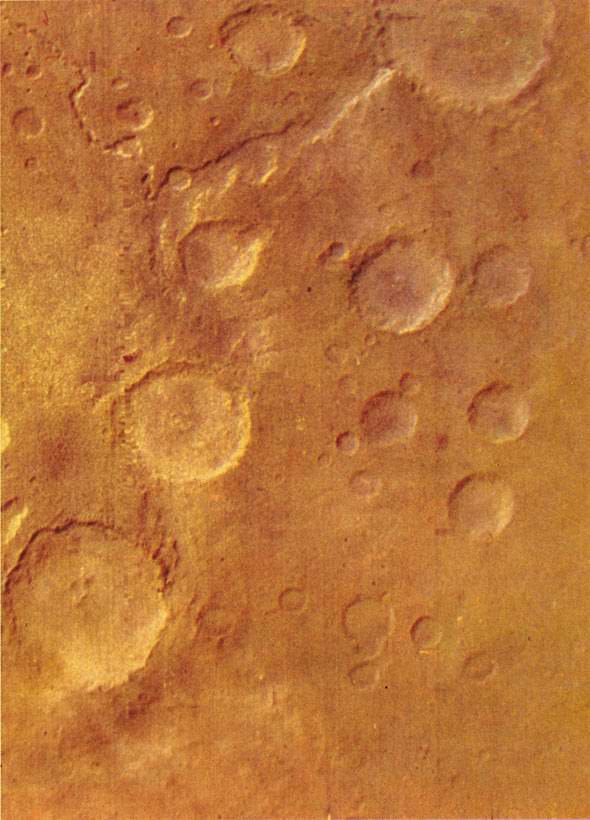
The last MRO satellite shoots in extended colors, so its frames cannot be called “true”, it looks light gray like ultramarine, and dark gray looks like deep blue. But I recommend everyone to go and admire the photo on the official website .
Upd. Two years later, after writing the article, you can add Mars from the Indian Mars Orbiter spacecraft :
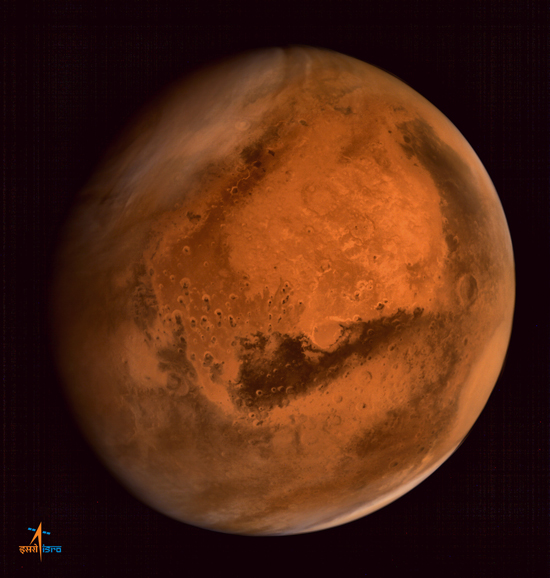
But with the Martian atmosphere and the color of the sky more interesting. If we turn again to the Hubble Martian images, many of them can see the blue atmospheric shell of Mars.
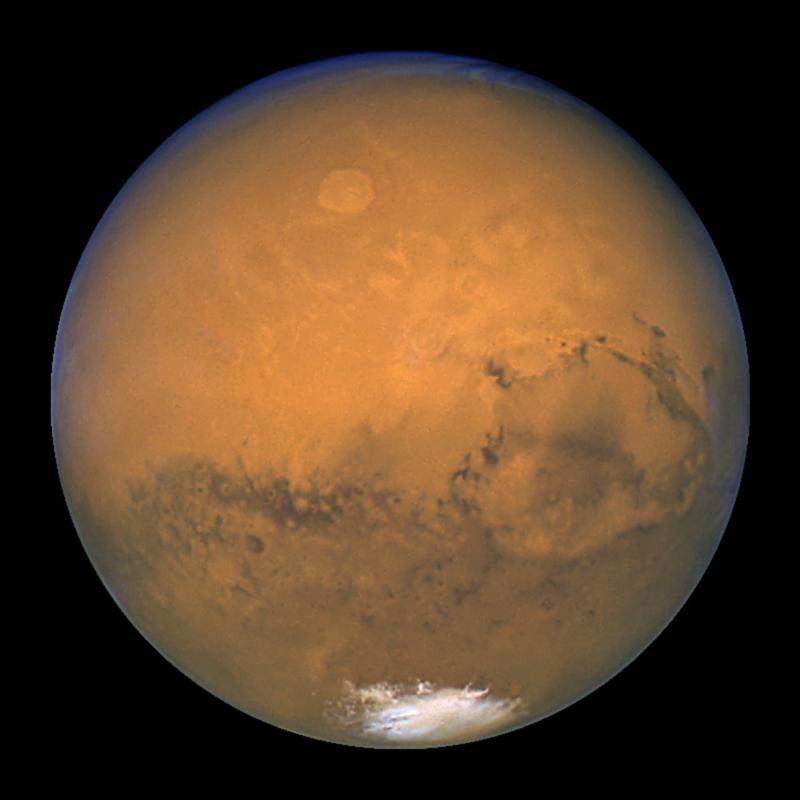
For conspiracy theorists are proof of the Martian conspiracy, saying that this is proof of the blue Martian sky. Proponents of this idea forget that both the Hubble and the Mars rovers are controlled by the same Jet Propulsion Laboratory (JPL) NASA. Therefore, it looks strange that they quietly publish compromising information on themselves. But logic and conspiracy never were friends, so we will continue.
The problem of the Martian blue atmosphere is that it is too thin. The atmosphere of Mars is from 1% to 0.75% of the Earth's atmosphere - the seasons affect the density. The pressure on the surface of Mars is the same as at an altitude of 30-40 km above the Earth. Accordingly, the sky there should be the same. When Felix Baumgartner jumped, everyone could see what the sky was there on a clear day.

Or just recently the Spaniards launched a prototype of a tourist stratostat for 32 km
But there is no black sky on Mars. So what's the deal? And the key to the same Martian rusty dust. It is very fine, dry, and gravity is three times weaker there, thanks to which dust can climb quite high even when there are no dust storms. There are even three types of clouds on Mars: water (from ice), carbon dioxide (also ice) and dust.
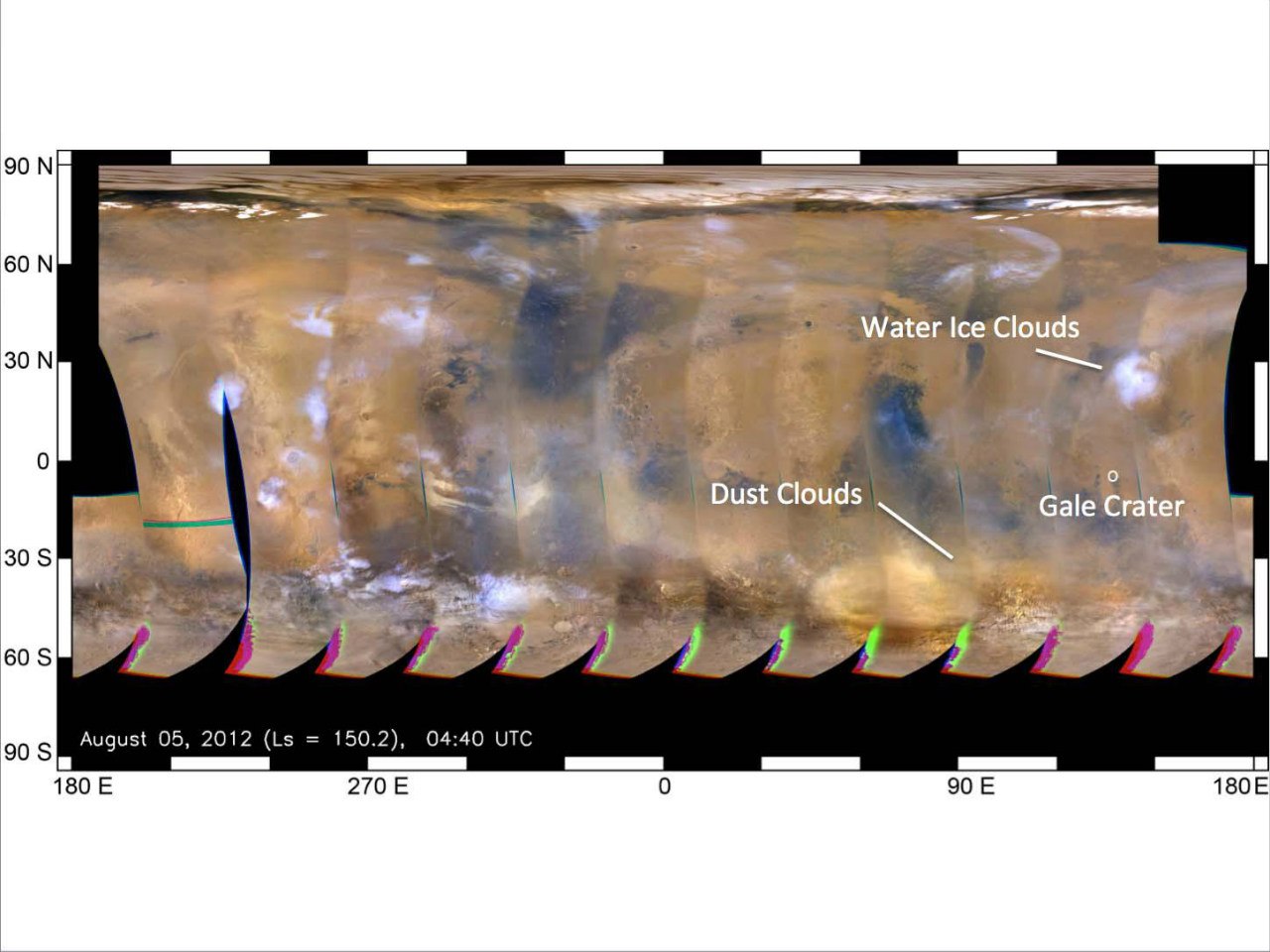
Due to the dust, the color of the Martian sky has various shades from pink to beige, and in a storm it is brown. And in calm weather it darkens noticeably to the zenith.
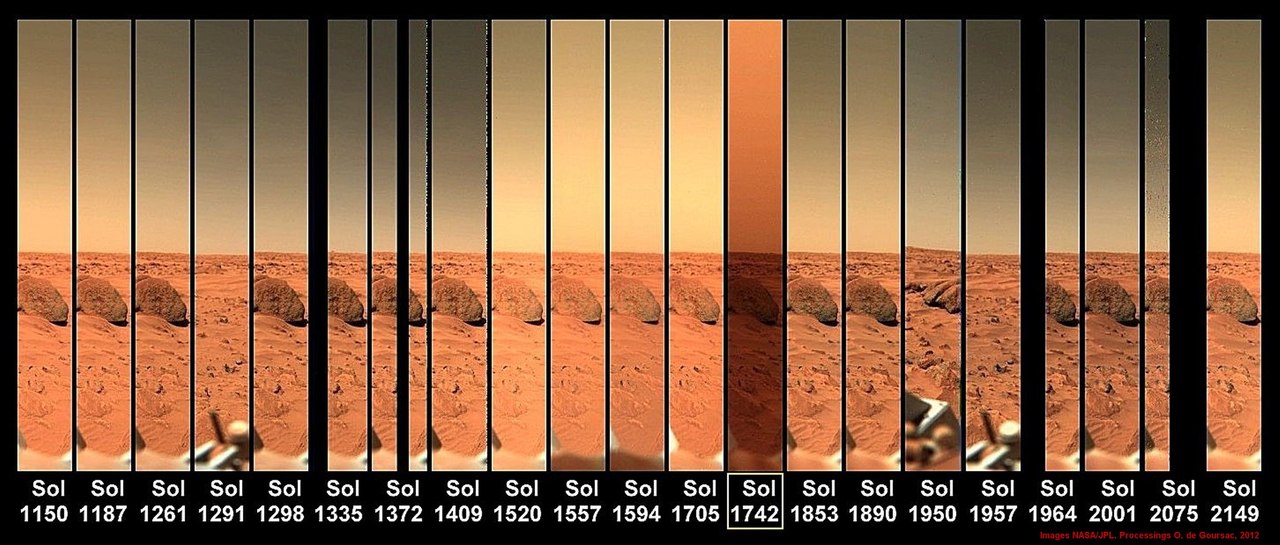
(Shooting Viking1 Lander, sol 1742 - dust storm)
At the same time at sunset and sunrise there is a unique chance to see the blue sky of Mars.

The color of the sky on Earth depends on Rayleigh scattering . The shortwave part of the spectrum from purple to blue disperses in the air, coloring our sky. When sunlight passes through a thicker layer of air — at sunset — longer waves, even red, are scattered, which we owe to our red sunsets. On Earth, sunlight near the horizon passes 38 times a thicker layer of air than at its zenith, and comparable scales can be imagined on Mars. But there, this thickness only allows you to see the blue in the sky, as we have on a clear day, and then only around the disk itself. And only the violet wave has time to disperse a little further.
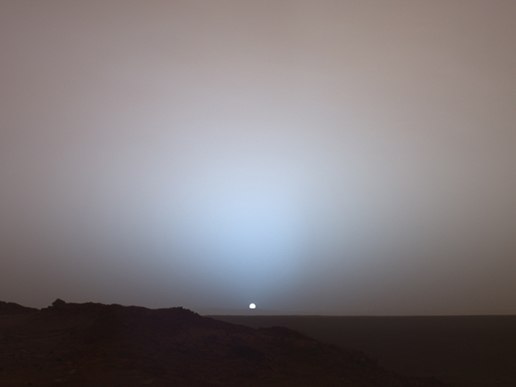
Unfortunately, Curiosity has not yet shot sunrises and sunsets, but there is an explanation. Unlike previous rovers that worked on the plain, the “curious” is located in a deep crater. It is surrounded by mountains, behind which the sun is hidden without having time to fade until it can be removed without a sun filter without fear of damaging the camera matrix with too intense light.

Perhaps the danger of such a light would not be fatal, especially recently when a local dust storm passed, but NASA is reinsured and removes only through a “welding mask”.
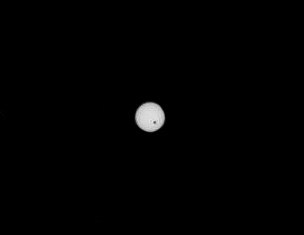
(the black dot is Deimos)
That's when Curiosity climbs up the mountain and can look beyond the crater, then there is hope to see the sunset or sunrise in high quality, but wait for this for at least another year.
In conclusion, I want to say that the color of Mars is almost the same non-permanent indicator as on Earth. There are no oceans and green spaces on Mars, but the time of year, time of day, weather, and the geological structure of the surrounding rocks affect which colors will be in a given area at one time or another. Blaming NASA for conspiracy is a meaningless business, if it were not for us, we would still have until now painted Martians sailing in their junks along channels along rice fields. Of course, there was a Soviet research program, there is Mars Express, but 90% of the information that we know about Mars we know thanks to NASA. And to check the accuracy of their information is enough to know the school course of physics and be able to read.
Literally three days after the publication of this post, Curiosity sent a survey of the Martian sky at its zenith. Shooting for 101 sol when the rover covered the distant echoes of a dust storm. Visibility has decreased from 30 to 10 km, but still the zenith is darker. White edge on the left - from the proximity of the sun.
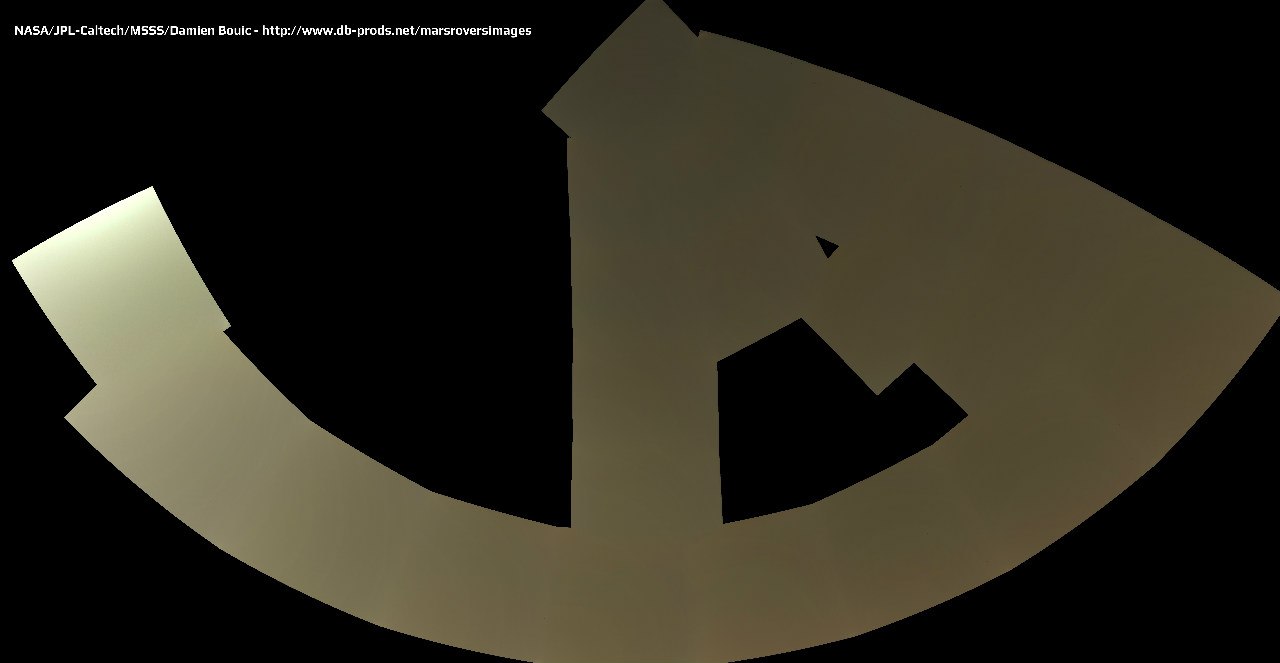
: What color is Mars?

To begin with, we will analyze all the main arguments of the supporters of the theory of “NASA hidden the color of Mars”. They do not have much evidence, but if they are not explained, doubts can arise even from a person far from conspiracy.
The favorite method of conspiracy therapists is to pull the facts, to ignore the explanations and to present them under their interpretation. Therefore, it is only necessary to show how manipulative all these conspiracy theories are. Yes, I think that the initiators of all these disclosures of conspiracies are well aware of their absurdity, but the losers is a valuable RuNet resource that can be converted into traffic and hundreds of links to your website or youtube channel.
So let's get started.
This whole story and hysteria began when photos from the Spirit and Opportunity twin rovers began to arrive in large quantities. Someone thought it strange that on Mars burgundy soil and beige sky, and then they came across an official picture of the Spirit landing platform.

“What is this?” - then the American losers gasped, unable to read the descriptions under the photo - “Why is the NASA emblem burgundy and not blue?”.
')
And really, why? NASA will not be so stupid to burn: to hide the true color of Mars (we will bypass the question why it is generally necessary), and at the same time leave color clues that any conspiracy theorist could expose the plot.
But all you had to do was look at the description of the photo and find out that these frames were made using not the red filter, but the infrared one. Color photographs on the twin rovers were created by shooting a black and white camera through different color filters. There, each camera had seven filters with different wavelengths, slightly different on the right and left, among which was red and infrared.

Read more about getting color images from the rover cameras: it has been written for a long time .
A bit of theory: the color frame is obtained if you shoot through three filters: red, green and blue (RGB format: red, green, blue), and then combine three frames in Photoshop to get one color.

In some cases, NASA did not use a red filter, but an infrared filter. It was necessary in order to obtain extended information about the properties of the soil and the objects under study. After all, the camera rover - is primarily a scientific device, and only then a means for entertainment taxpayers. So the panorama, with the landing platform Spirit was removed using an infrared filter. But at the same time, the Opportunity platform was removed using red and in normal colors, as can be seen from the difference.

The emblem of NASA is not visible, but the blue electrical tape immediately catches the eye. But if you look at the difference in the soil in these two photos, then it is not so significant. It is “redder” through infrared, but you still cannot see it on the original green grass and blue sky.
The peculiarity of getting color shots through three filters caused another accusation of NASA that they post many black and white shots and very few color ones. First, “little color” is nonsense, because even before Curiosity, thousands of colored frames of Spirit and Opportunity were published, and dozens of huge 360-degree panoramas. Secondly, by laying out raw black and white frames made through color filters, NASA gives everyone the opportunity to make color images of Mars on their own. But conspiracy theorists master Photoshop only up to the Autocolor function, which they “restore the true color of Mars”, and the subtleties of working with color channels are unknown to them.

The next argument of the adherents of the Mars-Red exercise is a kind of BBC report about the work of NASA specialists. According to the program, the scientist is sitting at a working laptop, then journalists enter his office, and they ask something there.

But the conspiracy scientist shouts “Aha!” And pokes at the monitors behind the scientist’s back, and there’s no red Mars and blue sky. At the same time, the organization of conspirators on a global scale looks more than strange, where journalists with cameras quietly roam around the offices, looking to where they like it. But those who dream of catching NASA in a lie do not think about it.
So what's on that monitor? It shows the Cape Verde site of Victoria Crater, which explored Opportunity.

NASA scientists use processing for terrestrial lighting conditions in order to facilitate the definition of rocks of rocks that occur to rovers. Since geologists' eyes are accustomed to terrestrial conditions, the change in the color range of Martian images is made in the same direction. And these photos are not at all secret.
Here is Cape Cape St. Mary is next door to Cape Verde

A source
And this is generally hearty Cape St. Vincent.

A source
Or the crater of Santa Maria, which Opportunity drove last year

A source
But this photo was taken using 13 color filters.

A source
Can you imagine what would happen if journalists caught a scientist editing this photo? "NASA hides that the rovers landed on a rainbow!"
Just in the published photographs, an explanation of the type is always indicated: It is presented in different colors. Or in the case of this rainbow photo: It was taken using all 13 color filters. But those who see traces of conspiracy everywhere cannot read.
In addition, conspiracologists, apparently, do not know about the existence of dust. Otherwise, they would not take NASA as another proof of the conspiracy.

This is a memorial flag, placed in memory of the victims of 9/11 on the Opportunity manipulator. And attention is attracted by the fact that it seems that it is tinted in red. Conspiracy therapists think that this is proof of the use of the red filter, although it is simply red-colored Martian dust. The frame was taken in 2011, and if you look at the photos taken in 2004 at the beginning of the research operation, for 31 sol (Martian day), then there is a clean flag in our familiar colors.

When the big self-portrait of Curiosity appeared, there too some tried to look for traces of the plot.

“Something NASA emblem is kind of gray, but it’s blue,” but they also forgot about the dust. The MSL was not landed using inflated cocoons, like previous rovers, but with the help of Sky Crane, so that it was sprayed on from the first seconds on Mars.

UPD. Applying the brush to the surface of Mars showed its natural color.

They also tell a certain story about how the first image of Mars was obtained from the landing gear Viking 1.

The book, the authors of which prove that there is life on Mars, and NASA hides it (Mars: The Living Planet, by B. Di Gregorio, G. Levin and P. Straat, Frog Ltd, Berkeley, 1997) tells the story of first shot. According to their testimonies, JPL gathered journalists, placed color television sets everywhere, and after receiving a snapshot from Mars, they immediately brought it to the screens. The picture allegedly had a blue sky and green spots on the stones. After that, as described in the book, NASA experts ran from the monitor to the monitor, twisting their color setting so that the photograph of Mars was in red. It is no longer possible to check the authenticity of this story, but there are two significant points: first, the color Viking frame was obtained in the same way as on the twin rovers - by combining three black and white images, so there was no signal from Mars that needed would immediately display on monitors; secondly, if an image was transmitted from the next room on the monitors, where the color reduction of the frame was made, wouldn’t it be easier to replace it with “red” and continue broadcasting than to attract attention by adjusting the monitors in front of everyone?
Thanks to the hysteria injected by the conspiracy theorists, the question began to worry: so what is the color of Mars and the Mars sky in reality? Let's see.
The main culprit of the red color of Mars is iron oxides, or simply rust. Martian crust was very rich in iron ore. For example, the plateau of Meridiani, where Opportunity rides is simply strewn with hematite - iron balls formed in shallow water bodies or groundwater.

Under the influence of water in an oxidizing atmosphere, iron turns to rust, which, as those who work with metal can easily know, easily becomes fine, fine dust. And once there was a lot of liquid water on the planet for a long time, so Mars had time to turn red. According to NASA observations, all the dust on Mars has magnetic properties, i.e. contains impurities of iron.
Martian storms carry dust even to places where there is not much iron in the soil. For example, in the Gale crater, at the landing site of Curiosity, the jet streams of the landing gear blew away dust and a gray surface emerged.

But in a matter of days, everything returned to the usual red picture.

But in general, the landscapes there are lighter than on the plateau of Miridiani.
In the same way, the rover itself was covered with dust, therefore, considering its color markers and the body, or trying to restore the “true color”, it should be borne in mind that it contains red Martian dust.
I don’t want to touch on the subtleties of color calibration white balance here. We tried it once, but I'm not happy with the results and have already got used to the “raw” (raw) colors of Curiosity.

Formats more
Let me just say that the Curiosity color cameras, unlike their predecessors, have a standard color Bayer filter on the Kodak KAI-2020 CCD matrix, so they shoot like ordinary SLR cameras. The difference in color reproduction depends on the white balance setting. But on Earth, adjustments to the color balance of the camera were made by people who knew what a particular color would look like at one or another color temperature. There are no people on Mars yet, so there is no one who could say “This is the right color” and slight variations of color are taking place. For supporters of the theory that NASA is shooting everything through a red filter to hide the green Mars, I’ll share the secret that in Curiosity's raw images there is just a slight bend in yellow-green.

So what Mars looks like from space is much easier. We have photos of "Viking"

Hubble

Mars odyssey

If someone does not trust NASA can look at the images of the European satellite Mars Express

The photo at the beginning of the article is also his.
Or a beautiful true-color photograph of a European satellite Rosetta

(Round "horseshoe" just to the left and below the center - Gale's crater )
Or even the Soviet "Mars-5"

The last MRO satellite shoots in extended colors, so its frames cannot be called “true”, it looks light gray like ultramarine, and dark gray looks like deep blue. But I recommend everyone to go and admire the photo on the official website .
Upd. Two years later, after writing the article, you can add Mars from the Indian Mars Orbiter spacecraft :

But with the Martian atmosphere and the color of the sky more interesting. If we turn again to the Hubble Martian images, many of them can see the blue atmospheric shell of Mars.

For conspiracy theorists are proof of the Martian conspiracy, saying that this is proof of the blue Martian sky. Proponents of this idea forget that both the Hubble and the Mars rovers are controlled by the same Jet Propulsion Laboratory (JPL) NASA. Therefore, it looks strange that they quietly publish compromising information on themselves. But logic and conspiracy never were friends, so we will continue.
The problem of the Martian blue atmosphere is that it is too thin. The atmosphere of Mars is from 1% to 0.75% of the Earth's atmosphere - the seasons affect the density. The pressure on the surface of Mars is the same as at an altitude of 30-40 km above the Earth. Accordingly, the sky there should be the same. When Felix Baumgartner jumped, everyone could see what the sky was there on a clear day.

Or just recently the Spaniards launched a prototype of a tourist stratostat for 32 km
But there is no black sky on Mars. So what's the deal? And the key to the same Martian rusty dust. It is very fine, dry, and gravity is three times weaker there, thanks to which dust can climb quite high even when there are no dust storms. There are even three types of clouds on Mars: water (from ice), carbon dioxide (also ice) and dust.

Due to the dust, the color of the Martian sky has various shades from pink to beige, and in a storm it is brown. And in calm weather it darkens noticeably to the zenith.

(Shooting Viking1 Lander, sol 1742 - dust storm)
At the same time at sunset and sunrise there is a unique chance to see the blue sky of Mars.

The color of the sky on Earth depends on Rayleigh scattering . The shortwave part of the spectrum from purple to blue disperses in the air, coloring our sky. When sunlight passes through a thicker layer of air — at sunset — longer waves, even red, are scattered, which we owe to our red sunsets. On Earth, sunlight near the horizon passes 38 times a thicker layer of air than at its zenith, and comparable scales can be imagined on Mars. But there, this thickness only allows you to see the blue in the sky, as we have on a clear day, and then only around the disk itself. And only the violet wave has time to disperse a little further.

Unfortunately, Curiosity has not yet shot sunrises and sunsets, but there is an explanation. Unlike previous rovers that worked on the plain, the “curious” is located in a deep crater. It is surrounded by mountains, behind which the sun is hidden without having time to fade until it can be removed without a sun filter without fear of damaging the camera matrix with too intense light.

Perhaps the danger of such a light would not be fatal, especially recently when a local dust storm passed, but NASA is reinsured and removes only through a “welding mask”.

(the black dot is Deimos)
That's when Curiosity climbs up the mountain and can look beyond the crater, then there is hope to see the sunset or sunrise in high quality, but wait for this for at least another year.
In conclusion, I want to say that the color of Mars is almost the same non-permanent indicator as on Earth. There are no oceans and green spaces on Mars, but the time of year, time of day, weather, and the geological structure of the surrounding rocks affect which colors will be in a given area at one time or another. Blaming NASA for conspiracy is a meaningless business, if it were not for us, we would still have until now painted Martians sailing in their junks along channels along rice fields. Of course, there was a Soviet research program, there is Mars Express, but 90% of the information that we know about Mars we know thanks to NASA. And to check the accuracy of their information is enough to know the school course of physics and be able to read.
Literally three days after the publication of this post, Curiosity sent a survey of the Martian sky at its zenith. Shooting for 101 sol when the rover covered the distant echoes of a dust storm. Visibility has decreased from 30 to 10 km, but still the zenith is darker. White edge on the left - from the proximity of the sun.

: What color is Mars?
Source: https://habr.com/ru/post/160621/
All Articles